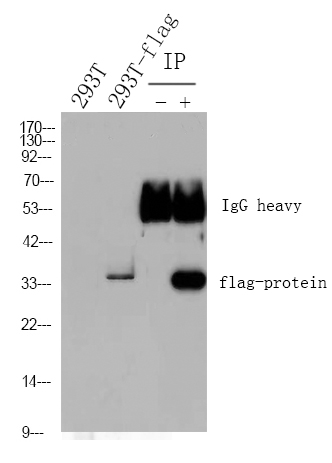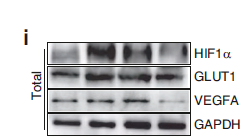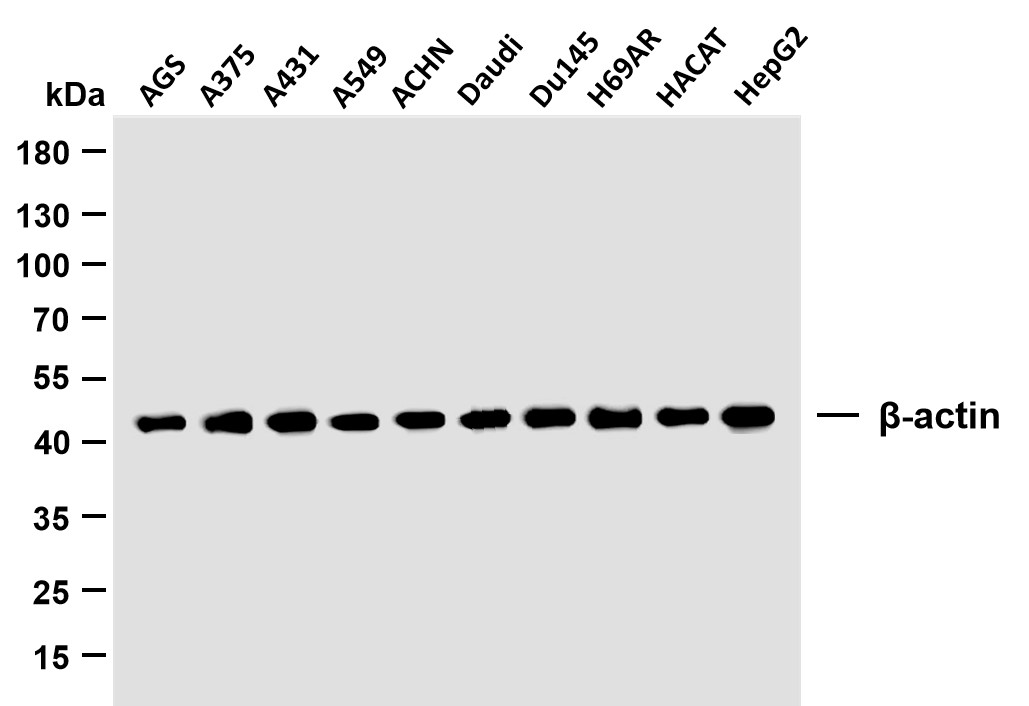
主要信息
Target
AXIN1
Host Species
Rabbit
Reactivity
Human, Mouse, Rat
Applications
WB, IHC
MW
94kD (Observed)
Conjugate/Modification
Unmodified
货号: YN0494
规格
价格
货期
数量
200μL
¥3,780.00
现货
0
100μL
¥2,300.00
现货
0
40μL
¥960.00
现货
0
加入购物车


已收藏


收藏
详细信息
推荐稀释比
WB 1:500-2000; ELISA 1:5000-20000
组成
Liquid in PBS containing 50% glycerol, and 0.02% sodium azide.
特异性
AXIN1 Polyclonal Antibody detects endogenous levels of protein.
纯化工艺
The antibody was affinity-purified from rabbit antiserum by affinity-chromatography using epitope-specific immunogen.
储存
-15°C to -25°C/1 year(Do not lower than -25°C)
浓度
1 mg/ml
实测条带
94kD
修饰
Unmodified
克隆性
Polyclonal
同种型
IgG
相关产品
抗原&靶点信息
免疫原:
Synthesized peptide derived from human protein . at AA range: 190-270
展开内容
特异性:
AXIN1 Polyclonal Antibody detects endogenous levels of protein.
展开内容
基因名称:
AXIN1 AXIN
展开内容
蛋白名称:
Axin-1 (Axis inhibition protein 1) (hAxin)
展开内容
背景:
This gene encodes a cytoplasmic protein which contains a regulation of G-protein signaling (RGS) domain and a dishevelled and axin (DIX) domain. The encoded protein interacts with adenomatosis polyposis coli, catenin beta-1, glycogen synthase kinase 3 beta, protein phosphate 2, and itself. This protein functions as a negative regulator of the wingless-type MMTV integration site family, member 1 (WNT) signaling pathway and can induce apoptosis. The crystal structure of a portion of this protein, alone and in a complex with other proteins, has been resolved. Mutations in this gene have been associated with hepatocellular carcinoma, hepatoblastomas, ovarian endometriod adenocarcinomas, and medullablastomas. Alternative splicing results in multiple transcript variants. [provided by RefSeq, Jan 2016],
展开内容
功能:
Disease:Defects in AXIN1 are involved in hepatocellular carcinoma (HCC) [MIM:114550].,Disease:Hypermethylation of the AXIN1 promoter may be associated with caudal duplication anomaly [MIM:607864]. Caudal duplication anomaly is characterized by the occurrence of duplications of different organs in the caudal region.,Function:Controls dorsoventral patterning via two opposing effects; down-regulates beta-catenin to inhibit the Wnt signaling pathway and ventralize embryos, but also dorsalizes embryos by activating a Wnt-independent JNK signaling pathway. In Wnt signaling, probably facilitates the phosphorylation of beta-catenin and APC by GSK3B. Likely to function as a tumor suppressor. Facilitates the phosphorylation of TP53 by HIPK2 upon ultraviolet irradiation. Wild-type axin 1 can induce apoptosis in hepatocellular and colorectal cancer cells. Enhances TGF-beta signaling by recruiting the RNF111 E3 ubiquitin ligase and promoting the degradation of inhibitory SMAD7.,PTM:Probably phosphorylated by GSK3B and dephosphorylated by PP2A.,similarity:Contains 1 DIX domain.,similarity:Contains 1 RGS domain.,subunit:Homodimer (By similarity). Interacts with TP53 and HIPK2. Probably part of a complex consisting of TP53, HIPK2 and AXIN1. Interacts with glycogen synthase kinase-3 beta (GSK3B) and beta-catenin. The interaction between axin and beta-catenin occurs via the armadillo repeats contained in beta-catenin. Ternary complex. Also binds to plakoglobin (gamma-catenin), APC, DVL and PP2A. Interacts with SMAD6, SMAD7 and RNF111. Interacts with DIXDC1; prevents interaction with MAP3K1. Interacts with MAP3K4, MDFI and MDFIC. Interacts with ANKRD6. Interacts with AIDA.,tissue specificity:Ubiquitously expressed.,
展开内容
细胞定位:
Cytoplasm . Nucleus . Membrane . Cell membrane . MACF1 is required for its translocation to cell membrane (By similarity). On UV irradiation, translocates to the nucleus and colocalizes with DAAX (PubMed:17210684). .
展开内容
组织表达:
Ubiquitously expressed.
展开内容
研究领域:
>>Wnt signaling pathway ;
>>Hippo signaling pathway ;
>>Signaling pathways regulating pluripotency of stem cells ;
>>Cushing syndrome ;
>>Alzheimer disease ;
>>Pathways of neurodegeneration - multiple diseases ;
>>Human papillomavirus infection ;
>>Pathways in cancer ;
>>Colorectal cancer ;
>>Endometrial cancer ;
>>Basal cell carcinoma ;
>>Breast cancer ;
>>Hepatocellular carcinoma ;
>>Gastric cancer
>>Hippo signaling pathway ;
>>Signaling pathways regulating pluripotency of stem cells ;
>>Cushing syndrome ;
>>Alzheimer disease ;
>>Pathways of neurodegeneration - multiple diseases ;
>>Human papillomavirus infection ;
>>Pathways in cancer ;
>>Colorectal cancer ;
>>Endometrial cancer ;
>>Basal cell carcinoma ;
>>Breast cancer ;
>>Hepatocellular carcinoma ;
>>Gastric cancer
展开内容
信号通路
Cellular Processes >> Cellular community - eukaryotes >> Signaling pathways regulating pluripotency of stem cells
Human Diseases >> Cancer: overview >> Pathways in cancer
Human Diseases >> Cancer: specific types >> Colorectal cancer
Human Diseases >> Cancer: specific types >> Hepatocellular carcinoma
Human Diseases >> Cancer: specific types >> Gastric cancer
Human Diseases >> Cancer: specific types >> Basal cell carcinoma
Human Diseases >> Cancer: specific types >> Endometrial cancer
Human Diseases >> Cancer: specific types >> Breast cancer
Human Diseases >> Neurodegenerative disease >> Alzheimer disease
Human Diseases >> Neurodegenerative disease >> Pathways of neurodegeneration - multiple diseases
Environmental Information Processing >> Signal transduction >> Wnt signaling pathway
Environmental Information Processing >> Signal transduction >> Hippo signaling pathway
文献引用({{totalcount}})
货号: YN0494
规格
价格
货期
数量
200μL
¥3,780.00
现货
0
100μL
¥2,300.00
现货
0
40μL
¥960.00
现货
0
加入购物车


已收藏


收藏
Recently Viewed Products
Clear allToggle night Mode
{{pinfoXq.title || ''}}
Catalog: {{pinfoXq.catalog || ''}}
Filter:
All
{{item.name}}
{{pinfo.title}}
-{{pinfo.catalog}}
主要信息
Target
{{pinfo.target}}
Reactivity
{{pinfo.react}}
Applications
{{pinfo.applicat}}
Conjugate/Modification
{{pinfo.coupling}}/{{pinfo.modific}}
MW (kDa)
{{pinfo.mwcalc}}
Host Species
{{pinfo.hostspec}}
Isotype
{{pinfo.isotype}}
产品 {{index}}/{{pcount}}
上一个产品
下一个产品
{{pvTitle}}
滚轮缩放图片
{{pvDescr}}





















